Chapter 5
The Suit of Science
THE CHALLENGE OF SELF-UNDERSTANDING.
STRIVING TO KNOW
SELF & WORLD.
THE
PATH OF INTELLECT & LEARNING.
What are all the
gifts of the spirit but mental gifts.
—Characteristics
of the Suit
—The Number Cards
1-Intellect
2-Reflection
3-Jealousy
4-Repose
5-Division
6-Passage
7-Lamentation
8-Restriction
9-Despair
10-Defeat
—The
Person Cards
Angel
of Science
Child of Science
Woman of Science
Man of Science
Characteristics
of the Suit
The Creative Process Suit of Science
represents the intellectual use of divine imagination, or the failure to use
it. It corresponds to the Suit of Swords in conventional Tarot. Its symbol is
the compass, which literally means 'with paces'; that is, to take equal steps
in order to measure something. Urizen, the Zoa of Mind, presides over this suit,
whose element is Air. Science is associated with knowledge, with the sense of
(external) vision, and with intellectual precision such as required in architecture
('mastery of manual arts') and engineering ('art of ingenuity'). The cards in
this suit portray situations and states of being that pertain to the mind or
its achievements — in short, to anything that is created and has mental
form, for "the increase...of a man is from internal improvement or intellectual
acquirement." Pertaining to works of art, Science specifically includes
the study and practice of such disciplines as physics ('science of nature'),
astronomy ('arranging of stars'), astrology ('speaking to stars'), and philosophy
('love of learning'). It also includes the many crafts and skills that involves
structuring things or thoughts. In general, anything based on reason, logic,
and memory is included in this suit. Therefore, technology ('speaking through
the hands'), politics ('science of cities'), economics ('household management'),
and history ('knowledge') are also part of Science, although as "degraded"
or fallen forms.
Historians...cannot see either miracle
or prodigy; all is to them a dull round of probabilities and possibilities.
Basically, the Suit of Science applies
imagination to one's external vision, and attempts to shape the world of nature.
The true scientist-technician-thinker-academic creates forms in the external
world using the imagination, whereas the "degraded" scientist applies
created forms to suppress imagination — one "who publishes doubt &
calls it knowledge; whose science is despair." In this sense, "Science
is the tree of death."
Imagination is the immortal power
of forming images in the mind, and Science is the mortal power of applying those
images to gain knowledge and control over oneself and the environment. If the
mind is passive and unimaginative, it allows reason to become a tyrant that
creates inhumane laws and unholy machines.
Study sciences
till you are blind
Study intellectuals till you are cold
Yet science cannot teach intellect.
The Suit of Science, like its corresponding
Suit of Swords in the traditional Tarot, is the most 'negative' of the suits
in its deck, unfolding "dark visions of torment." To Blake, the star-crossed
intellect is the contrary of the sunny imagination, and he says that unless
the intellect is emotionally joined to the imagination (as in Beulah and Eden),
the spectrous intellect inevitably leads to self-cruelty and defeat, as in this
suit. Nevertheless, every card in the suit can also be interpreted within the
framework of self-understanding and learning, and each points to imagination
as the means of elevating Science into the true arts of man. Furthermore, in
depicting Urizen as the adversary of imagination, Blake gives a body to error
so that it may be recognized and cast out.
Men are admitted into heaven not
because they have curbed & governd their passions or have no passions but because
they have cultivated their understandings.
The borders of all the suit cards
depict stars, which Blake associates with the intellect (speculation upon the
universe). The inner edges of the card borders are yellow to symbolize its element
of air. The faint design in the Symbol Windows suggests the idea of Structure
that underlies this suit. All the cards of this suit are cautionary and instructive,
insistently warning of the dangers of self-centered consciousness.
The Number
Cards
The ten Number Cards in the Suit
of Science are all from The Book of Urizen, giving them both visual and symbolic
continuity. The plot of Blake's book is a parody of the human birth process,
a "ninefold darkness" in which Urizen's body of error is created with
Los's help. It can also be considered a Blakean retelling, in seven 'ages',
of Genesis in the bible. The story unfolds as a perverse gestation that concludes
with Urizen being fettered in his own selfish consciousness — a metaphor
for the mind enslaved by reason instead of freed by imagination. Urizen becomes
one of the "giants who formed this world into its sensual existence and
now seem to live in it in chains." Although Los appears in this book, he
has not yet evolved into his heroic aspect as the prophet of eternity; here
he is a false prophet who is controlled by Urizen's power. A relevant metaphor
in the story is the tent called "science," erected over Los and Enitharmon
to limit them — representing Science as an enclosure for time and space.
Ace of
Science—Intellect
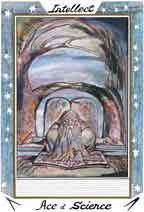 This
card comes from the book's title page, and depicts the Zoa of Mind as a blind
patriarch squatting on an open book, writing with his right hand while etching
with his left. From the edges of the open book descend roots indicating that
these ideas are from nature, not the imagination. Behind the figure are tombstones
representing spiritual death; they are also Mosaic tablets of moral law that
limit individual freedoms. Arching over the whole tableau is the forest of error,
part of which encloses the mind in a burial chamber. Urizen, the "dark
power," creates the mental world of intellect and consciousness, but lacks
creative vision. He writes down natural laws and scientific truths without understanding
their implications. Blake stressed that error must be recognized before it can
be cast out, and thus Urizen's situation is instructive.Behind him is an open
space of sky, which is the means to imaginative freedom — he has only to
turn around and see it. (Compare with XVII—Stars.)
This
card comes from the book's title page, and depicts the Zoa of Mind as a blind
patriarch squatting on an open book, writing with his right hand while etching
with his left. From the edges of the open book descend roots indicating that
these ideas are from nature, not the imagination. Behind the figure are tombstones
representing spiritual death; they are also Mosaic tablets of moral law that
limit individual freedoms. Arching over the whole tableau is the forest of error,
part of which encloses the mind in a burial chamber. Urizen, the "dark
power," creates the mental world of intellect and consciousness, but lacks
creative vision. He writes down natural laws and scientific truths without understanding
their implications. Blake stressed that error must be recognized before it can
be cast out, and thus Urizen's situation is instructive.Behind him is an open
space of sky, which is the means to imaginative freedom — he has only to
turn around and see it. (Compare with XVII—Stars.)
This card is about acquiring and
retaining new knowledge. It is pure mental perception that neither sees nor
judges, but simply records. Here we accumulate and document information without
emotion or judgement. We are poised, balanced in the midst of ideas for their
own sake, absorbing and taking them in. It may seem like we are walking blind
through a forest of overwhelming possibilities, gathering details without yet
knowing how they will fit into the final product. This card can also mean the
ability to see both sides of a situation objectively. It indicates a single-focused
input with multiple outputs.
In the creative process, this is
when you stuff your brain with knowledge. The image depicts the brain itself,
the 'seat' of intellect, showing both the left and right hemispheres, and its
'blind' absorption of data.
KEYWORDS: INTELLECT • BEGINNING
OF A NEW IDEA • MENTAL FOCUS AND CLARITY • ACQUISITION OF KNOWLEDGE
• OBSESSION WITH ACHIEVEMENT • OBJECTIVITY • WILLPOWER •
ABILITY TO DO MULTIPLE THINGS • OPPORTUNITY FOR MENTAL BREAKTHROUGH •
INTELLECTUAL WORKAHOLIC • SELF-CENTEREDNESS •
2 of Science—Reflection
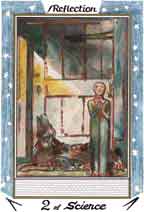 This
card shows a child standing with his back to a mysterious door that is slightly
ajar. Beside him is a dog who growls at the opening. An opening or opportunity
awaits, which may be longed for or feared. Both figures seem to be reflecting
on their next move. Across the door falls a streak of dark shadow and a burst
of golden light. Trepidation and hope are equal possibilities. With which figure
do you most identify? What are you doing there and on what are you reflecting?
Although the door may be an opportunity for growth and adventure, it could,
on the other hand, indicate something to be avoided or guarded against. It intimates
unusual or unknown consequences. Although inviting, it might better be left
unopened. One of your choices here is not to choose.
This
card shows a child standing with his back to a mysterious door that is slightly
ajar. Beside him is a dog who growls at the opening. An opening or opportunity
awaits, which may be longed for or feared. Both figures seem to be reflecting
on their next move. Across the door falls a streak of dark shadow and a burst
of golden light. Trepidation and hope are equal possibilities. With which figure
do you most identify? What are you doing there and on what are you reflecting?
Although the door may be an opportunity for growth and adventure, it could,
on the other hand, indicate something to be avoided or guarded against. It intimates
unusual or unknown consequences. Although inviting, it might better be left
unopened. One of your choices here is not to choose.
Blake called this image "Dog
at the wintry door," and means it as a commentary on the plight of children
exploited in factories and as chimney sweeps and beggars. He wants to arouse
our sympathies: "Then cherish pity, lest you drive an angel from your door."
He wants us to recognize innocence at the entryway to experience.
The dog and the child suggest two
different approaches to a choice or decision: animal instinct versus human logic
— with the child having the added meaning of imagination. In effect, both
faculties are begging to be chosen; meanwhile, they block the door. They might
also represent potential action versus self-reflecting reverie. The card shows
a point at which no choice has yet been made, and compromise or arbitration
may be required.
In the creative process, this is
when you speculate on potentials and possibilities in your imagination. You
must choose which method or course to which to commit — divergent versus
conventional thinking, perhaps.
KEYWORDS: REFLECTION • MENTAL
CHOICES • UNCERTAINTY • TENSION • AN UNEASY PEACE OR DELICATE
BALANCE • CAUTION • BEGGING FOR A DECISION • WAITING • PROCRASTINATION
• NEED FOR COMPROMISE • ENTRYWAY •
3 of Science—Jealousy
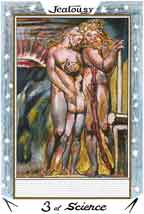 This
card shows a naked family: a man in chains holds a long hammer, while next to
him, with her forehead pressed to his, leans a woman embracing a clinging child.
This is Enitharmon and Los (who represent imagination), and their son Orc (who
represents revolution). The child, literally "fed with milk of Enitharmon,"
is the object of Los's hatred, symbolized by the "chain of jealousy"
that dangles from his breast. Los will eventually chain Orc in vengeance. What
should be a loving family takes on insinuations of sexual slavery and heartbreak.
This is jealousy as mental imprisonment.
This
card shows a naked family: a man in chains holds a long hammer, while next to
him, with her forehead pressed to his, leans a woman embracing a clinging child.
This is Enitharmon and Los (who represent imagination), and their son Orc (who
represents revolution). The child, literally "fed with milk of Enitharmon,"
is the object of Los's hatred, symbolized by the "chain of jealousy"
that dangles from his breast. Los will eventually chain Orc in vengeance. What
should be a loving family takes on insinuations of sexual slavery and heartbreak.
This is jealousy as mental imprisonment.
The chain is the dominant symbol.
It signifies bondage to sex — note how the male's erect penis is assimilated
into the links of the chain. It is also the "endless chain of sorrows"
that links all the generations of humanity in psychosexual torments involving
Oedipal conflicts and jealousies. And it is the chain of nature, or what 18th-century
writers called the 'chain of being', which Blake took to mean the enslavement
of the mind and imagination within the biological constrictions of the body.
And it represents the reasoning mind's enslavement of the spiritual impulse
— Blake's "mind-forg'd manacles" that bind language and thought
in rules of law and religion. Finally, it represents the chain of time (for
Los is also the time-lord) that binds man to mortality, emphasizing again that
freedom can only be found in the spiritual life. Los (a smithgod) holds a hammer
that he could presumably use to shatter the chain, but jealousy, by its nature,
disorders and paralyzes the mind. The setting of the spiritual sun in the background
dramatizes their sorrow, but it could also be rising on new opportunity.
Hope appears in the continuing attempts
to communicate (foreheads touching) to find some ground of understanding. Current
jealousies may be based on old pains that we inappropriately apply to the present
situation. Cooperation is implied here, as all parties are in bodily contact.
Honesty by baring the soul and following the feeling to its source, each within
ourselves, can help release old pains and bring growth.
In the creative process, this is
when you feel chained by convention, needs, or requirements. You may become
jealous of others who are not as constrained. Seek honest communication and
cooperation to avoid frustration and paralysis.
KEYWORDS: JEALOUSY • SEXUAL
OBSESSION • HEARTACHE • SORROW • MENTAL PAIN AND CONSTRICTION
• LACK OF FREEDOM • MENTAL DISTRACTION OR CONFUSION • FORCED
COOPERATION • MENTAL ADJUSTMENT THROUGH THE EXPERIENCE OR SHARING OF PAIN
•
4 of Science—Repose
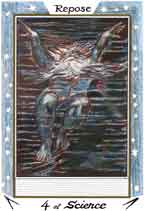 This
is Blake's image of Urizen "brooding, shut in the deep" of the sea
of time and space — the world of materialism. "In dark secresy"
he hides his fantasies in "surgeing sulphureous fluid." Sulphur signifies
vital heat and is associated with reason and the male principle; in other words,
he suppresses his burning thoughts. An inscription on the print declares, "I
labour upwards into futurity." In his mind, he believes he is going somewhere,
but his slack knees and beard show he is drifting and relaxing despite himself.
His outstretched arms mimic divinity, but his palms are down-turned — he
is a mock god in exile from his element of air, recuperating from the exertion
of his endless tyranny of dispassionate logic and reason. 'Repose' literally
means to put back, to restore, and in this card the mind puts itself back into
its elemental container; immersion in the water of the body prevents sulphurous
mental burnout.
This
is Blake's image of Urizen "brooding, shut in the deep" of the sea
of time and space — the world of materialism. "In dark secresy"
he hides his fantasies in "surgeing sulphureous fluid." Sulphur signifies
vital heat and is associated with reason and the male principle; in other words,
he suppresses his burning thoughts. An inscription on the print declares, "I
labour upwards into futurity." In his mind, he believes he is going somewhere,
but his slack knees and beard show he is drifting and relaxing despite himself.
His outstretched arms mimic divinity, but his palms are down-turned — he
is a mock god in exile from his element of air, recuperating from the exertion
of his endless tyranny of dispassionate logic and reason. 'Repose' literally
means to put back, to restore, and in this card the mind puts itself back into
its elemental container; immersion in the water of the body prevents sulphurous
mental burnout.
This card is about taking time-out
from life's daily struggle, and letting yourself be swept along without struggling
against the current. Rest from mental activity is required here, perhaps through
getting lost in the healing flow of meditation, or a spa, or other mode of relaxation.
This is only a temporary retreat — a need to let go of concerns. This kind
of mental truce allows ideas to settle and consolidate themselves into a natural
harmonization of elements. After such a release from tension and anxiety, you
may find that the solution will simply float to the surface.
In the creative process, this is
when you let go of previous restrictions, letting bafflement take over. When
you relax and let go, taking time off from work, new insights will surface.
KEYWORDS: REPOSE • REST
FROM MENTAL ACTIVITY • RECOVERY OF SELF • RETREAT INTO ANOTHER ELEMENT
• SELF-ABSORBED SOLITUDE OR SECLUSION • TRUCE • MENTAL CONSOLIDATION
• HARMONIZATION OF IDEAS • BROODING THOUGHTS • FORCED WITHDRAWAL
• DISCONNECTED SELF-OPINION •
5 of Science—Division
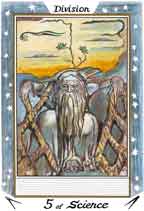 Here
we see Urizen more enmeshed than ever in his web of reason. "None could
break the web...so twisted the cords, & so knotted the meshes, twisted like
to the human brain. And all call'd it the net of religion." This net is
the false religion of laws and judgement, of logic and Deism that denies divinity
(see V-Religion). Blake sees this "dark net of infection" as dividing
the cities in the "form of a human heart...bound down to earth by...narrowing
perceptions." Thus, Urizen's net, ironically heart-shaped, divides him
from others and from his imaginative potential. Only his right shoulder is caught,
but his free left arm free wraps the net tighter. This is the essential division
within Urizen's nature: his self-constrictive dualism.
Here
we see Urizen more enmeshed than ever in his web of reason. "None could
break the web...so twisted the cords, & so knotted the meshes, twisted like
to the human brain. And all call'd it the net of religion." This net is
the false religion of laws and judgement, of logic and Deism that denies divinity
(see V-Religion). Blake sees this "dark net of infection" as dividing
the cities in the "form of a human heart...bound down to earth by...narrowing
perceptions." Thus, Urizen's net, ironically heart-shaped, divides him
from others and from his imaginative potential. Only his right shoulder is caught,
but his free left arm free wraps the net tighter. This is the essential division
within Urizen's nature: his self-constrictive dualism.
This card shows you so divided by
your mental conflicts that you become paralyzed or weighed down by inertia.
Negative thinking is limiting your possibilities and creating an aura of defeat.
Action is inhibited. You are not receptive to help, having become so ensnared
in your own reasons that you can see no others.
Hope is seen in the new plant seemingly
rising from the head or center of the divided figure, sprouting flowers on both
sides. Some plants propagate best by dividing their roots. The figure can emerge
from the net by dividing it. When a task becomes too great, a city too large,
a plant too overgrown, division is necessary. A group of problems taken together
cannot be solved, but dividing them can be a means to success.
In the creative process, this is
when you feel weighted down by the enormity of the problem or project. Try to
divide it into smaller segments that you can handle or step around.
KEYWORDS: DIVISION • MENTAL
FRAGMENTATION • NEGATIVE THINKING • NARROWED PERCEPTIONS • VICTIMIZATION
• UNFAIR OR UNDERHANDED TACTICS • LOSS OF FRIENDS OR PURPOSE •
DIVIDE AND CONQUER • NEW HOPE FROM OLD RESTRICTIONS •
6 of Science—Passage
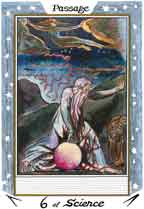 Two
scenes from the book are collaged into one image. Below, Urizen explores his
"dens, mountain, moor, & wilderness, with a globe of fire," while
above, a naked woman pushes back obscuring clouds to reveal the firmament. Urizen
blindly strides, left foot forward, on a "fearful journey" through
"forsaken mountains," encountering "cruel enormities" and
"dread terrors" writhing in the sky. His globe of imagination is enclosed
by his selfishness, and its black flames provide no light. He does not see the
lion, who seems ready to offer guidance or even humor (which Urizen lacks although
Blake does not). The lion is our ignored instincts, and life's exotic surprises.
The unseen lion and the blackened globe represent lost opportunities, much like
the classic tourist who carries the wrong luggage, overlooks the natives, and
misses all the fun. Nevertheless, this traveler pushes forward with a sense
of purpose, feeling his way as he goes.
Two
scenes from the book are collaged into one image. Below, Urizen explores his
"dens, mountain, moor, & wilderness, with a globe of fire," while
above, a naked woman pushes back obscuring clouds to reveal the firmament. Urizen
blindly strides, left foot forward, on a "fearful journey" through
"forsaken mountains," encountering "cruel enormities" and
"dread terrors" writhing in the sky. His globe of imagination is enclosed
by his selfishness, and its black flames provide no light. He does not see the
lion, who seems ready to offer guidance or even humor (which Urizen lacks although
Blake does not). The lion is our ignored instincts, and life's exotic surprises.
The unseen lion and the blackened globe represent lost opportunities, much like
the classic tourist who carries the wrong luggage, overlooks the natives, and
misses all the fun. Nevertheless, this traveler pushes forward with a sense
of purpose, feeling his way as he goes.
The woman is Enitharmon, the imagination
at work, who tries to shed light on the struggling Urizen. The stars she reveals
are the Pleiades and the belt of Orion, the former representing wisdom and the
latter, the foolish hunter. In her left hand she grasps the moon and in her
right the sun, so that she is herself the passage or mediator between the contraries
of female and male, the unconscious and conscious modes. Her negative aspect
is in her alternative role as pity, which "divides the soul."
With this card, passage is possible
to new lands, to a higher level of consciousness, or to a place of objectivity
where you can gain perspective or get an overview. Once set in motion, keep
the ball rolling. Take advantage of the resources and opportunities offered.
You do not journey alone; let imagination be your guide.
In the creative process, this shows
where opportunities may be overlooked by blindly pushing forward without pausing
for reassessment. Stay open to making adjustments based on new circumstances
encountered in the process. Get an overview of your progress.
KEYWORDS: PASSAGE, TRAVEL •
RITE OF PASSAGE • JOURNEY OF CONSCIOUSNESS • MENTAL OVERVIEW OR PERSPECTIVE
• HELP FROM HIGHER UP • MOVEMENT AWAY FROM DIFFICULTIES TO RESTORE
HARMONY • MEDIATION BETWEEN CONTRARY STATES • OPPORTUNITIES OVERLOOKED
• DEPRESSION OR DANGER •
7 of Science—Lamentation
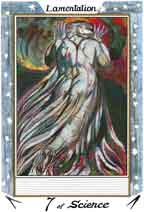 Here
we see Urizen energetically moving away from us with his hands raised beside
his head. He could be wailing in sorrow, fleeing from a situation he 'can't
handle', or straining against something, especially the globe of fire from the
preceding card. In the story, Urizen "sickend to see...that no flesh or
spirit could keep his iron laws." The realization of this failure becomes
a lament of "weeping & pain & woe." So, leading with his unspiritual
foot, he flees in self-protective sorrow, and attempts to push the globe of
light (his imagination/soul), trying to 'get away with something'. In doing
so, he blocks the spiritual light. His energetically flowing robe is the complex
emotional residue of his actions, which are "stretch'd from the sorrows
of Urizen's soul." Positively, this card can be interpreted as someone
using sorrow to reshape his thoughts or plans, to extract energy and strength
from his turbulent mind, or just resisting the oppressing pressure.
Here
we see Urizen energetically moving away from us with his hands raised beside
his head. He could be wailing in sorrow, fleeing from a situation he 'can't
handle', or straining against something, especially the globe of fire from the
preceding card. In the story, Urizen "sickend to see...that no flesh or
spirit could keep his iron laws." The realization of this failure becomes
a lament of "weeping & pain & woe." So, leading with his unspiritual
foot, he flees in self-protective sorrow, and attempts to push the globe of
light (his imagination/soul), trying to 'get away with something'. In doing
so, he blocks the spiritual light. His energetically flowing robe is the complex
emotional residue of his actions, which are "stretch'd from the sorrows
of Urizen's soul." Positively, this card can be interpreted as someone
using sorrow to reshape his thoughts or plans, to extract energy and strength
from his turbulent mind, or just resisting the oppressing pressure.
This card is about the pain of not
trusting the imagination. You may feel like your task is impossible. You want
to put your head into the fire and scream with pain. You may 'push your weight
around', or if direct action seems futile, try to 'get away with something'.
Such tactics are selfbetraying and lamentable. Just as the body strengthens
from pushing against something, so does the mind. The 7 cards are tests, and
this is a test of the mind. Let your lamentation be a springboard for self-renewal.
Use your wits to develop a new strategy. Gather ideas and materials. Resist
the negative pressures. Look directly at what you have to work with and mold
it as best you can.
In the creative process, this is
when you are stuck or 'pushing it'. You wail at the wall or boundary. Be compassionate
with yourself and others involved; take infinite pains to find a way around
the problem or to develop a new strategy.
KEYWORDS: LAMENTATION •
MENTAL TESTS • DISAPPOINTMENT • DEFEATIST THOUGHTS • RUNNING
AWAY FROM PROBLEMS • UNSTABLE EFFORT • MANIPULATION OF IDEAS •
MANIPULATION OF SITUATIONS • GATHERING IDEAS AND MATERIALS • SHAPING
AND PREPARING • RESISTING PRESSURE •
8 of Science—Restriction
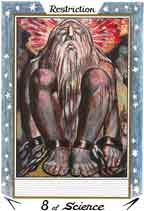 Urizen,
still weeping, has ceased resisting and is now bound in irons. He has reached
a "state of dismal woe," manacled by his own abstract ratiocinations.
His closed eyes signify that he exists in spiritual darkness. Desiring to enforce
"one command, ...one weight, one measure, ...one God, one law," he
has become "in chains of the mind locked up." Limbs contracted to
his torso, he is an aged fetus, his wisdom imprisoned within his own dogmatism.
This is an image of the "eternal mind" trapped in the mortal flesh,
making us focus on the needs of the body instead of the spirit. Blake's inscription
to this image, "Frozen doors to mock the world" suggests that Urizen
is a metaphor for a living book of knowledge that is rendered useless, its wisdom
locked between frozen covers. Even so, the intellectual light and creative fire
of the "eternal mind" still emanate from the figure's head.
Urizen,
still weeping, has ceased resisting and is now bound in irons. He has reached
a "state of dismal woe," manacled by his own abstract ratiocinations.
His closed eyes signify that he exists in spiritual darkness. Desiring to enforce
"one command, ...one weight, one measure, ...one God, one law," he
has become "in chains of the mind locked up." Limbs contracted to
his torso, he is an aged fetus, his wisdom imprisoned within his own dogmatism.
This is an image of the "eternal mind" trapped in the mortal flesh,
making us focus on the needs of the body instead of the spirit. Blake's inscription
to this image, "Frozen doors to mock the world" suggests that Urizen
is a metaphor for a living book of knowledge that is rendered useless, its wisdom
locked between frozen covers. Even so, the intellectual light and creative fire
of the "eternal mind" still emanate from the figure's head.
Distrusting your own power, you
may have willingly accepted obstacles and interference to avoid the potential
consequences of your actions. Or perhaps you are restricted by circumstances
for the purpose of concentrating on spiritual matters. The closed eyes indicate
a focus upon an inner reality. Eventually the energy of applied imagination
can break the bonds of materialism, as shown by the exploding matter in the
background. Use your ingenuity and intuition rather than brute force to liberate
yourself.
In the creative process, this is
where you transcend feeling trapped by impossible limits. Necessity forces improvisation;
structure ignites spontaneity; limits yield intensity. The more constraint,
the greater the spiritual freedom.
KEYWORDS: RESTRICTION •
MENTAL BLOCKS OR OBSTACLES • SELF-IMPOSED BLINDNESS • CONSTRICTIVE
ATTITUDES • LIMITED BY DOGMATIC IDEAS • SUPPRESSED ENERGY OR CREATIVITY
• FEELINGS OF HELPLESSNESS • LATENT IMAGINATIVE POWER • MENTAL
FREEDOM DESPITE PHYSICAL RESTRICTION •
9 of Science—Despair
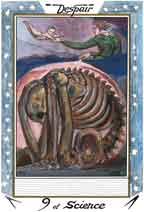 The
skeletal Urizen hunches in the fetal position, while collaged above a woman
extends her hand to a hovering infant. Blake's describes the skeleton as being
"in a horrible, dreamful slumber...a vast spine writh'd in torment upon
the winds...like a bending cavern; and bones of solidness froze over all his
nerves of joy." Consciousness is in dread sleep within the bodily cave
that confines us, trying to avoid the pain of mortality that kills the joy of
life. Nightmares of the intellect shrivel us into a ball of self-inflicted despair.
This is the soul in the power of the Spectre: "the Almighty has made me
his contrary...knowing and seeing life, yet living not."
The
skeletal Urizen hunches in the fetal position, while collaged above a woman
extends her hand to a hovering infant. Blake's describes the skeleton as being
"in a horrible, dreamful slumber...a vast spine writh'd in torment upon
the winds...like a bending cavern; and bones of solidness froze over all his
nerves of joy." Consciousness is in dread sleep within the bodily cave
that confines us, trying to avoid the pain of mortality that kills the joy of
life. Nightmares of the intellect shrivel us into a ball of self-inflicted despair.
This is the soul in the power of the Spectre: "the Almighty has made me
his contrary...knowing and seeing life, yet living not."
Protecting its head, the figure
shrinks from expected blows. These are projections of one's own fears arising
from the perfectionism that rationalism expects. Guilt and depression can cause
us to hide from innocent joy, or to withdraw from the weight of the world's
sorrows. This card depicts the mind tormented by its own demons — grief
from past failures, or the soul's suffering when personal wrongs or society's
problems seem uncorrectable. Despairing over what went wrong, we may take the
blame upon our own heads.
The woman and child in the plane
above are symbols of acceptance and hope. The woman, her hair bound as a matron,
depicts the inner maturity and emotional stability that can penetrate the black
cloud of despair, as she does with her right or spiritual hand. She is the earthy
green spirit of love and forgiveness. The child she welcomes is the skeleton's
pure soul, who looks compassionately at its alter ego. The possibility of regeneration
comes when we forgive not only ourselves but those who have hurt us. The self-enfolded
skeleton positively represents integrity of structure and intrinsic wholeness.
Pain is necessary but temporary. Grief and despair can take us back to the essence
or "bare bones" of who we are, stripping us of everything that is
incidental. We can reclaim our innocence; we can rebirth ourselves.
In the creative process, this is
where criticism and inner grief overwhelms you. Judgements block creativity
and produce rigidity and doubt. Go within yourself and think back to where you
began; forgive your mistakes and recapture the initial innocence.
KEYWORDS: DESPAIR • MENTAL
ANGUISH • SELF-PITY • DEPRESSION ¥ WRACKED WITH GUILT • FEAR
OF PUNISHMENT • SENSE OF ISOLATION • INSOMNIA AND NIGHTMARES •
. PUTTING YOURSELF DOWN ¥ STRIPPING TO BASICS • SOUL-RETRIEVAL • SELF-FORGIVENESS
• INTENSE CONTEMPLATIVE WITHDRAWAL •
10 of
Science — Defeat
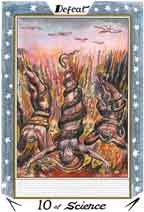 This
card shows three figures encircled by serpents of death, falling head-first
into a pit of fire. Two faces peer out from the flames, while eagles circle
overhead. In Blake's plot, Urizen, furious with the other Eternals for opposing
him, consigns them in his mind to "unquenchable burnings." In this
view, the divine qualities in man are defeated by the forces of tyranny, and
are painfully lost in the infernal abyss of materialism. Likewise, you may find
yourself entangled in the slander or machinations of others, and headed for
a fall. This could arise from being 'too smart for your own good', or from unavoidable
situations reflecting your worst fears. If defeat is inevitable, you can still
surrender with grace, your thoughts imaginatively circling above. The two faces
peering from the flames are the perennially contending spirits of life who ritually
defeat each other: the one on the left, old and wizened, represents repression
and loss; the other is young and leonine, representing energy and life.
This
card shows three figures encircled by serpents of death, falling head-first
into a pit of fire. Two faces peer out from the flames, while eagles circle
overhead. In Blake's plot, Urizen, furious with the other Eternals for opposing
him, consigns them in his mind to "unquenchable burnings." In this
view, the divine qualities in man are defeated by the forces of tyranny, and
are painfully lost in the infernal abyss of materialism. Likewise, you may find
yourself entangled in the slander or machinations of others, and headed for
a fall. This could arise from being 'too smart for your own good', or from unavoidable
situations reflecting your worst fears. If defeat is inevitable, you can still
surrender with grace, your thoughts imaginatively circling above. The two faces
peering from the flames are the perennially contending spirits of life who ritually
defeat each other: the one on the left, old and wizened, represents repression
and loss; the other is young and leonine, representing energy and life.
This image also illustrates Blake's
statement that "the modern church crucifies Christ with the head downwards"
— meaning that Christ today would be considered a rebel angel or a devil,
condemned by secular society for his sacred imagination. Perhaps you are being
crucified for unpopular or rebellious actions. Your choice is epitomized in
the three figures: Two cringe in fear, while the central figure calmly accepts
his fate. He exultantly prefigures transformation and resurrection — the
attitude of life-in-death that is the touchstone of spiritual consciousness.
Material defeat and death to Blake mean spiritual victory and eternal life.
This requires the voluntary sacrifice of the scientific reasoning mind. Those
who despair at this will perish, for we must die to material consciousness in
order to serve the imagination. The birds in the card are the ennobled phoenixes
that rise from the ashes of sacrifice.
In the creative process, this is
when difficulties consume you, and your work goes down in flames. Defeat is
a form of intellectual bondage, and must be transcended. Physical or materialistic
suffering is the quickest path to spiritual breakthrough.
KEYWORDS: INTELLECTUAL DEFEAT
• SPIRITUAL VICTORY • DESCENT INTO PERSONAL HELL • HUNG-UP OVER
MATERIALISTIC FEARS • WRAPPED IN VICES • ACCEPTANCE AND RESIGNATION
• SACRIFICE AND SURRENDER • DEFEAT OF THE REASONING SELF • MISFORTUNE
• RUIN • ADDICTION •
The Person
Cards
The central images used in the four
Person Cards of the Suit of Science are selected from a variety of Blake's works.
Angel
of Science
(Air of Air — Mind of Mind)
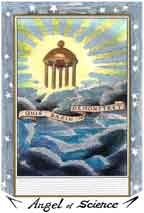 Ironically,
this image is from the title page of a scientific textbook advocating the rational
materialism that Blake despised. Therefore, this is Blake's satiric comment
on the scientific and intellectual idealism that separates us from our prophetic
imagination, or soul. The card depicts a radiant temple in the sky, a veritable
'brass tower' of the mind whose foundations are hidden behind a bank of ephemeral
clouds. The angel is apparent only as a circle of white light illuminating a
geometry of Ionic precision and philosophical starkness. The breeze-blown banner
asks Who would demonstrate the foundation of such a structure? This is a lofty
Deistic vision, a literally classical projection of overglorified intellectuality.
The Angel of Science is so abstracted that it has no human features. It is an
abstract angel of air supported by a vaporous structure of mind. The muse of
intellect offers you pure, objective mind coupled with clear, unemotional and
unbiased thinking.
Ironically,
this image is from the title page of a scientific textbook advocating the rational
materialism that Blake despised. Therefore, this is Blake's satiric comment
on the scientific and intellectual idealism that separates us from our prophetic
imagination, or soul. The card depicts a radiant temple in the sky, a veritable
'brass tower' of the mind whose foundations are hidden behind a bank of ephemeral
clouds. The angel is apparent only as a circle of white light illuminating a
geometry of Ionic precision and philosophical starkness. The breeze-blown banner
asks Who would demonstrate the foundation of such a structure? This is a lofty
Deistic vision, a literally classical projection of overglorified intellectuality.
The Angel of Science is so abstracted that it has no human features. It is an
abstract angel of air supported by a vaporous structure of mind. The muse of
intellect offers you pure, objective mind coupled with clear, unemotional and
unbiased thinking.
This is the part of yourself or
another that believes in answer and explanation for everything, or a law by
which things can be understood: absolute justice, universal principles. It is
wanting to 'know' for knowledge's sake. You crave mental stimulation. This is
like a bright idea, a light bulb in your head. It taps the invisible power inherent
in maps, diagrams, equations, measurements, relational databases and spreadsheets,
so as to mediate between us and the physical world, and spirit as truth. This
muse can take the form of an environment, atmosphere, or attitude conducive
to mental focus.
The archangel Gabriel can be associated
with the Suit of Science, for it acts as the chief messenger of God. Gabriel
('God my strength') is the angel of truth and celestial revelation. Gabriel
appeared to Mary to tell her to name her son Jesus. Although Gabriel is not
related to the Angel of Science, both angels can bring fresh perspectives, or
stimulate enlightening ideas.
In the creative process, this is
the pure inspiration that can come in a flash of transparent thought, and you
are likely to know how to apply it to your work.
KEYWORDS: RATIONAL MATERIALISM
• FOCUSED INVOLVEMENT WITH ABSTRACT ISSUES • ISSUES OF CLARITY VERSUS
ILLUSION • SCIENTIFIC AND INTELLECTUAL IDEALISM • UNEMOTIONAL AND
UNBIASED THINKING • MENTAL STIMULATION • A BRIGHT IDEA • WORKING
WITH MAPS OF UNDERSTANDING • INTELLECTUAL SELF-ABSORPTION •
Child
of Science
(Earth of Air
— Spirit
of Mind)
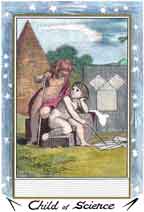 This
card from an engraving for the title page of a 1782 children's textbook of science
and measurement. A child points to a sketch of the Pythagorean theorem, also
drawn on the adjacent stone wall. Mathematics is shown to be the 'ground of
existence'. Pythagoras was a 6th century B.C. Greek mathematician and philosopher
who taught that numbers form the underlying basis of reality, an idea that began
the ultimately successful effort of Science to separate spirit from matter.
(Blake responds that "God is not a mathematic diagram.") This scientific
child, and his alter ego, are grounded in ratiocination and materialism and
thus lack spirit and imagination (only their left feet touch the ground). On
the other hand, the child represents the spirit of learning; he nakedly seeks
truth and openly communicates what he discovers.
This
card from an engraving for the title page of a 1782 children's textbook of science
and measurement. A child points to a sketch of the Pythagorean theorem, also
drawn on the adjacent stone wall. Mathematics is shown to be the 'ground of
existence'. Pythagoras was a 6th century B.C. Greek mathematician and philosopher
who taught that numbers form the underlying basis of reality, an idea that began
the ultimately successful effort of Science to separate spirit from matter.
(Blake responds that "God is not a mathematic diagram.") This scientific
child, and his alter ego, are grounded in ratiocination and materialism and
thus lack spirit and imagination (only their left feet touch the ground). On
the other hand, the child represents the spirit of learning; he nakedly seeks
truth and openly communicates what he discovers.
Of the two aspects of the child,
one is dark, partially cloaked and its face obscured, with long hair, and staff
grounded in the earth. The other child is light, open, with bound hair, and
baton as teaching tool. The twin-aspected Child of Science, one dark and wild,
the other light and groomed, are the airy twins of Gemini being schooled in
the pagan and natural sciences. The outdoor environment, with its various representations
of nature, indicates that the phenomenal world is the subject of their speculations.
This is the part of yourself or
another that likes to figure things out; that plans, measures, divides, and
describes. Or you could be considering some campaign or strategy, acting as
the brains behind the pack. We see symbols of classical knowledge and wisdom:
the pyramid, Pythagorean geometry, and stones of permanence. This child looks
for permanent truths and underlying infallible laws to explain or direct action.
He wants to know the layout and the ground plan before moving in. Innocence
questions everything, and its mental agility and quick-wittedness can clear
up any mess. Communication, negotiation, and diplomacy can be your tools. This
is a serious child, ready to defend his position. Taken to an extreme or threatened,
he can become critical, cynical, quarrelsome, spiteful, and scheming.
In the creative process, this is
when you first put pencil to paper to come up with an outline or a plan, or
you talk it through with a friend. This can be the initial stages of organization
and research to find out if something is actually feasible.
KEYWORDS: DEVELOPING MENTAL POWERS
• LOVE OF LEARNING • RATIONAL VIEW OF NATURE • CONSCIOUS AND
SUBCONSCIOUS COMMUNICATION • SEEKING TRUTH • PRECOCIOUSNESS •
INTELLECTUAL DUALISM • MENTAL QUICKNESS •
Woman
of Science
(Water of Air — Matter of Mind)
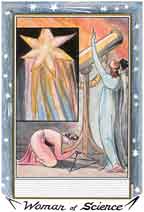 This
card is a collage of two designs from Edward Young's Night Thoughts, illustrating
the line, "Ye searching, ye Newtonian, angels! tell, where, your great
Master's orb? His planets, where?" Here the triple feminine is involved
in Newtonian (that is, scientific) pursuits, bathing in the glow of illumination
from above. The "bold comet" in the window symbolizes the love of
knowledge and the cosmic energy that characterizes the Woman of Science. Seven-pointed,
the comet can be interpreted as Sophia, the goddess of wisdom, and her seven
planetary spirits, the seven pillars of her temple, and the seven legendary
priestesses who founded the oracle-shrines of the ancient world. The telescope
indicates an ability to see at a distance, a form of intellectual scrying.
This
card is a collage of two designs from Edward Young's Night Thoughts, illustrating
the line, "Ye searching, ye Newtonian, angels! tell, where, your great
Master's orb? His planets, where?" Here the triple feminine is involved
in Newtonian (that is, scientific) pursuits, bathing in the glow of illumination
from above. The "bold comet" in the window symbolizes the love of
knowledge and the cosmic energy that characterizes the Woman of Science. Seven-pointed,
the comet can be interpreted as Sophia, the goddess of wisdom, and her seven
planetary spirits, the seven pillars of her temple, and the seven legendary
priestesses who founded the oracle-shrines of the ancient world. The telescope
indicates an ability to see at a distance, a form of intellectual scrying.
This is the part of yourself or
another who researches and studies things with care, who has exalted values
and ideas, who looks to the future, turning her back on what has not worked
in the past. The Woman of Science integrates what is possible (looks to the
big picture or overview), with care for details (laying the groundwork). She
freely offer her ideas and knowledge to others. An excellent teacher, counselor,
and business executive, she is highly disciplined, and pays attention to detail.
Communication and truth are central to her relationships. Seeing easily through
subterfuge, she judges with a critical mind and sharp tongue. Emotionally detached,
she is determined to maintain her perspective. Visionary but opinionated, her
intellectual curiosity is a blessing and a fault. In the the extreme, she can
be rigid and unyielding, looking to the principle rather than the particular,
and have an answer to everything.
In the creative process, this is
when you gather information to fit into a plan or design, and then look at suitable
strategies for progressing further.
KEYWORDS: MULTIPLE APPROACHES
OR ALTERNATIVES TO LEARNING • INNER INVESTIGATION • LOVE OF RESEARCH
AND KNOWLEDGE • SCRYING OR "SEEING FROM A DISTANCE." • PROFESSIONALISM
• AN INTEREST IN ASTROLOGY • SHARP AND CRITICAL • OPINIONATED
OR UNYIELDING VIEWS •
Man
of Science
(Fire of Air
— Passion of Mind)
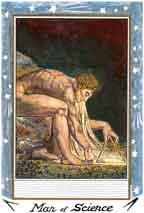 This
is from Blake's famous painting, Newton, which depicts the archscientist Isaac
Newton on the floor of the ocean of illusory materialism, seated on a stone,
bending forward to make measurements with a compass. Newton, who died 30 years
before Blake was born, is considered one of the greatest scientists of all times;
he discovered gravitation, developed optics, and invented calculus. Although
Blake respected his genius, he saw Newton as embodying all the Urizenic principles
of scientific rationality that denied the imagination and spiritual reality.
Dangling over his left shoulder is his rational cloak woven on "the loom
of Locke." On the rock beneath Newton's thigh is a squid, "polypus
of death...that vegetates beneath the deep," symbolizing the evils of human
society, whose tentacles reach into every man's life, bringing doubt and despair.
In Blake's view, Newton and his sciences serve a useful purpose by giving visible
form to error, making it vulnerable to eradication. Although surrounded by intellectual
darkness, Newton himself in his naked beauty, and his work, are brilliantly
illuminated by an inner light.
This
is from Blake's famous painting, Newton, which depicts the archscientist Isaac
Newton on the floor of the ocean of illusory materialism, seated on a stone,
bending forward to make measurements with a compass. Newton, who died 30 years
before Blake was born, is considered one of the greatest scientists of all times;
he discovered gravitation, developed optics, and invented calculus. Although
Blake respected his genius, he saw Newton as embodying all the Urizenic principles
of scientific rationality that denied the imagination and spiritual reality.
Dangling over his left shoulder is his rational cloak woven on "the loom
of Locke." On the rock beneath Newton's thigh is a squid, "polypus
of death...that vegetates beneath the deep," symbolizing the evils of human
society, whose tentacles reach into every man's life, bringing doubt and despair.
In Blake's view, Newton and his sciences serve a useful purpose by giving visible
form to error, making it vulnerable to eradication. Although surrounded by intellectual
darkness, Newton himself in his naked beauty, and his work, are brilliantly
illuminated by an inner light.
This is the part of yourself or
another who thinks, discriminates, and measures everything critically, with
high ideals. As a perfectionist, you can get stuck in ideation, and may have
difficulty putting things into practice. You worry over any ambiguity or unclear
consequences. The Man of Science is a loner, characterized by personal detachment
and self-possession. He knows something about everything, and is fascinated
by new topics. Full of ideas, he thinks they can solve the world's problems,
but may become cynical. An explorer and pioneer of the mind, he plots maps for
the rest of us to follow. He can be a researcher, analyst, strategist or theorist.
He names and classifies, defines principles. He teaches, preaches, and judges.
Taken to extreme, this part of you can be ruthless or vengeful, rarely listening
to others and seeing mistakes as someone else's fault. Beware of falling into
obsessive intellectuality, know-it-all snobbism, or calculated cruelty.
In the creative process, this is
when you refine and hone your work by submitting it to critical analysis, careful
measurements, and quality control.
KEYWORDS: GENIUS AT WORK •
IMMERSION IN MENTAL WORK • FOCUSED CONCENTRATION • EXCESSIVE RATIONALITY
• OBLIVIOUS TO SURROUNDINGS • PLOTS AND PLANS • NEARNESS OF MENTAL
DEPRESSION •
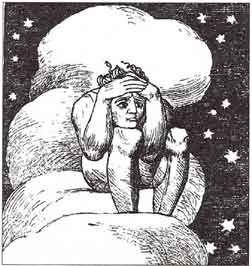
 This
card comes from the book's title page, and depicts the Zoa of Mind as a blind
patriarch squatting on an open book, writing with his right hand while etching
with his left. From the edges of the open book descend roots indicating that
these ideas are from nature, not the imagination. Behind the figure are tombstones
representing spiritual death; they are also Mosaic tablets of moral law that
limit individual freedoms. Arching over the whole tableau is the forest of error,
part of which encloses the mind in a burial chamber. Urizen, the "dark
power," creates the mental world of intellect and consciousness, but lacks
creative vision. He writes down natural laws and scientific truths without understanding
their implications. Blake stressed that error must be recognized before it can
be cast out, and thus Urizen's situation is instructive.Behind him is an open
space of sky, which is the means to imaginative freedom — he has only to
turn around and see it. (Compare with XVII—Stars.)
This
card comes from the book's title page, and depicts the Zoa of Mind as a blind
patriarch squatting on an open book, writing with his right hand while etching
with his left. From the edges of the open book descend roots indicating that
these ideas are from nature, not the imagination. Behind the figure are tombstones
representing spiritual death; they are also Mosaic tablets of moral law that
limit individual freedoms. Arching over the whole tableau is the forest of error,
part of which encloses the mind in a burial chamber. Urizen, the "dark
power," creates the mental world of intellect and consciousness, but lacks
creative vision. He writes down natural laws and scientific truths without understanding
their implications. Blake stressed that error must be recognized before it can
be cast out, and thus Urizen's situation is instructive.Behind him is an open
space of sky, which is the means to imaginative freedom — he has only to
turn around and see it. (Compare with XVII—Stars.)  This
card shows a child standing with his back to a mysterious door that is slightly
ajar. Beside him is a dog who growls at the opening. An opening or opportunity
awaits, which may be longed for or feared. Both figures seem to be reflecting
on their next move. Across the door falls a streak of dark shadow and a burst
of golden light. Trepidation and hope are equal possibilities. With which figure
do you most identify? What are you doing there and on what are you reflecting?
Although the door may be an opportunity for growth and adventure, it could,
on the other hand, indicate something to be avoided or guarded against. It intimates
unusual or unknown consequences. Although inviting, it might better be left
unopened. One of your choices here is not to choose.
This
card shows a child standing with his back to a mysterious door that is slightly
ajar. Beside him is a dog who growls at the opening. An opening or opportunity
awaits, which may be longed for or feared. Both figures seem to be reflecting
on their next move. Across the door falls a streak of dark shadow and a burst
of golden light. Trepidation and hope are equal possibilities. With which figure
do you most identify? What are you doing there and on what are you reflecting?
Although the door may be an opportunity for growth and adventure, it could,
on the other hand, indicate something to be avoided or guarded against. It intimates
unusual or unknown consequences. Although inviting, it might better be left
unopened. One of your choices here is not to choose.  This
card shows a naked family: a man in chains holds a long hammer, while next to
him, with her forehead pressed to his, leans a woman embracing a clinging child.
This is Enitharmon and Los (who represent imagination), and their son Orc (who
represents revolution). The child, literally "fed with milk of Enitharmon,"
is the object of Los's hatred, symbolized by the "chain of jealousy"
that dangles from his breast. Los will eventually chain Orc in vengeance. What
should be a loving family takes on insinuations of sexual slavery and heartbreak.
This is jealousy as mental imprisonment.
This
card shows a naked family: a man in chains holds a long hammer, while next to
him, with her forehead pressed to his, leans a woman embracing a clinging child.
This is Enitharmon and Los (who represent imagination), and their son Orc (who
represents revolution). The child, literally "fed with milk of Enitharmon,"
is the object of Los's hatred, symbolized by the "chain of jealousy"
that dangles from his breast. Los will eventually chain Orc in vengeance. What
should be a loving family takes on insinuations of sexual slavery and heartbreak.
This is jealousy as mental imprisonment.  This
is Blake's image of Urizen "brooding, shut in the deep" of the sea
of time and space — the world of materialism. "In dark secresy"
he hides his fantasies in "surgeing sulphureous fluid." Sulphur signifies
vital heat and is associated with reason and the male principle; in other words,
he suppresses his burning thoughts. An inscription on the print declares, "I
labour upwards into futurity." In his mind, he believes he is going somewhere,
but his slack knees and beard show he is drifting and relaxing despite himself.
His outstretched arms mimic divinity, but his palms are down-turned — he
is a mock god in exile from his element of air, recuperating from the exertion
of his endless tyranny of dispassionate logic and reason. 'Repose' literally
means to put back, to restore, and in this card the mind puts itself back into
its elemental container; immersion in the water of the body prevents sulphurous
mental burnout.
This
is Blake's image of Urizen "brooding, shut in the deep" of the sea
of time and space — the world of materialism. "In dark secresy"
he hides his fantasies in "surgeing sulphureous fluid." Sulphur signifies
vital heat and is associated with reason and the male principle; in other words,
he suppresses his burning thoughts. An inscription on the print declares, "I
labour upwards into futurity." In his mind, he believes he is going somewhere,
but his slack knees and beard show he is drifting and relaxing despite himself.
His outstretched arms mimic divinity, but his palms are down-turned — he
is a mock god in exile from his element of air, recuperating from the exertion
of his endless tyranny of dispassionate logic and reason. 'Repose' literally
means to put back, to restore, and in this card the mind puts itself back into
its elemental container; immersion in the water of the body prevents sulphurous
mental burnout.  Here
we see Urizen more enmeshed than ever in his web of reason. "None could
break the web...so twisted the cords, & so knotted the meshes, twisted like
to the human brain. And all call'd it the net of religion." This net is
the false religion of laws and judgement, of logic and Deism that denies divinity
(see V-Religion). Blake sees this "dark net of infection" as dividing
the cities in the "form of a human heart...bound down to earth by...narrowing
perceptions." Thus, Urizen's net, ironically heart-shaped, divides him
from others and from his imaginative potential. Only his right shoulder is caught,
but his free left arm free wraps the net tighter. This is the essential division
within Urizen's nature: his self-constrictive dualism.
Here
we see Urizen more enmeshed than ever in his web of reason. "None could
break the web...so twisted the cords, & so knotted the meshes, twisted like
to the human brain. And all call'd it the net of religion." This net is
the false religion of laws and judgement, of logic and Deism that denies divinity
(see V-Religion). Blake sees this "dark net of infection" as dividing
the cities in the "form of a human heart...bound down to earth by...narrowing
perceptions." Thus, Urizen's net, ironically heart-shaped, divides him
from others and from his imaginative potential. Only his right shoulder is caught,
but his free left arm free wraps the net tighter. This is the essential division
within Urizen's nature: his self-constrictive dualism.  Two
scenes from the book are collaged into one image. Below, Urizen explores his
"dens, mountain, moor, & wilderness, with a globe of fire," while
above, a naked woman pushes back obscuring clouds to reveal the firmament. Urizen
blindly strides, left foot forward, on a "fearful journey" through
"forsaken mountains," encountering "cruel enormities" and
"dread terrors" writhing in the sky. His globe of imagination is enclosed
by his selfishness, and its black flames provide no light. He does not see the
lion, who seems ready to offer guidance or even humor (which Urizen lacks although
Blake does not). The lion is our ignored instincts, and life's exotic surprises.
The unseen lion and the blackened globe represent lost opportunities, much like
the classic tourist who carries the wrong luggage, overlooks the natives, and
misses all the fun. Nevertheless, this traveler pushes forward with a sense
of purpose, feeling his way as he goes.
Two
scenes from the book are collaged into one image. Below, Urizen explores his
"dens, mountain, moor, & wilderness, with a globe of fire," while
above, a naked woman pushes back obscuring clouds to reveal the firmament. Urizen
blindly strides, left foot forward, on a "fearful journey" through
"forsaken mountains," encountering "cruel enormities" and
"dread terrors" writhing in the sky. His globe of imagination is enclosed
by his selfishness, and its black flames provide no light. He does not see the
lion, who seems ready to offer guidance or even humor (which Urizen lacks although
Blake does not). The lion is our ignored instincts, and life's exotic surprises.
The unseen lion and the blackened globe represent lost opportunities, much like
the classic tourist who carries the wrong luggage, overlooks the natives, and
misses all the fun. Nevertheless, this traveler pushes forward with a sense
of purpose, feeling his way as he goes.  Here
we see Urizen energetically moving away from us with his hands raised beside
his head. He could be wailing in sorrow, fleeing from a situation he 'can't
handle', or straining against something, especially the globe of fire from the
preceding card. In the story, Urizen "sickend to see...that no flesh or
spirit could keep his iron laws." The realization of this failure becomes
a lament of "weeping & pain & woe." So, leading with his unspiritual
foot, he flees in self-protective sorrow, and attempts to push the globe of
light (his imagination/soul), trying to 'get away with something'. In doing
so, he blocks the spiritual light. His energetically flowing robe is the complex
emotional residue of his actions, which are "stretch'd from the sorrows
of Urizen's soul." Positively, this card can be interpreted as someone
using sorrow to reshape his thoughts or plans, to extract energy and strength
from his turbulent mind, or just resisting the oppressing pressure.
Here
we see Urizen energetically moving away from us with his hands raised beside
his head. He could be wailing in sorrow, fleeing from a situation he 'can't
handle', or straining against something, especially the globe of fire from the
preceding card. In the story, Urizen "sickend to see...that no flesh or
spirit could keep his iron laws." The realization of this failure becomes
a lament of "weeping & pain & woe." So, leading with his unspiritual
foot, he flees in self-protective sorrow, and attempts to push the globe of
light (his imagination/soul), trying to 'get away with something'. In doing
so, he blocks the spiritual light. His energetically flowing robe is the complex
emotional residue of his actions, which are "stretch'd from the sorrows
of Urizen's soul." Positively, this card can be interpreted as someone
using sorrow to reshape his thoughts or plans, to extract energy and strength
from his turbulent mind, or just resisting the oppressing pressure.  Urizen,
still weeping, has ceased resisting and is now bound in irons. He has reached
a "state of dismal woe," manacled by his own abstract ratiocinations.
His closed eyes signify that he exists in spiritual darkness. Desiring to enforce
"one command, ...one weight, one measure, ...one God, one law," he
has become "in chains of the mind locked up." Limbs contracted to
his torso, he is an aged fetus, his wisdom imprisoned within his own dogmatism.
This is an image of the "eternal mind" trapped in the mortal flesh,
making us focus on the needs of the body instead of the spirit. Blake's inscription
to this image, "Frozen doors to mock the world" suggests that Urizen
is a metaphor for a living book of knowledge that is rendered useless, its wisdom
locked between frozen covers. Even so, the intellectual light and creative fire
of the "eternal mind" still emanate from the figure's head.
Urizen,
still weeping, has ceased resisting and is now bound in irons. He has reached
a "state of dismal woe," manacled by his own abstract ratiocinations.
His closed eyes signify that he exists in spiritual darkness. Desiring to enforce
"one command, ...one weight, one measure, ...one God, one law," he
has become "in chains of the mind locked up." Limbs contracted to
his torso, he is an aged fetus, his wisdom imprisoned within his own dogmatism.
This is an image of the "eternal mind" trapped in the mortal flesh,
making us focus on the needs of the body instead of the spirit. Blake's inscription
to this image, "Frozen doors to mock the world" suggests that Urizen
is a metaphor for a living book of knowledge that is rendered useless, its wisdom
locked between frozen covers. Even so, the intellectual light and creative fire
of the "eternal mind" still emanate from the figure's head.  The
skeletal Urizen hunches in the fetal position, while collaged above a woman
extends her hand to a hovering infant. Blake's describes the skeleton as being
"in a horrible, dreamful slumber...a vast spine writh'd in torment upon
the winds...like a bending cavern; and bones of solidness froze over all his
nerves of joy." Consciousness is in dread sleep within the bodily cave
that confines us, trying to avoid the pain of mortality that kills the joy of
life. Nightmares of the intellect shrivel us into a ball of self-inflicted despair.
This is the soul in the power of the Spectre: "the Almighty has made me
his contrary...knowing and seeing life, yet living not."
The
skeletal Urizen hunches in the fetal position, while collaged above a woman
extends her hand to a hovering infant. Blake's describes the skeleton as being
"in a horrible, dreamful slumber...a vast spine writh'd in torment upon
the winds...like a bending cavern; and bones of solidness froze over all his
nerves of joy." Consciousness is in dread sleep within the bodily cave
that confines us, trying to avoid the pain of mortality that kills the joy of
life. Nightmares of the intellect shrivel us into a ball of self-inflicted despair.
This is the soul in the power of the Spectre: "the Almighty has made me
his contrary...knowing and seeing life, yet living not."  This
card shows three figures encircled by serpents of death, falling head-first
into a pit of fire. Two faces peer out from the flames, while eagles circle
overhead. In Blake's plot, Urizen, furious with the other Eternals for opposing
him, consigns them in his mind to "unquenchable burnings." In this
view, the divine qualities in man are defeated by the forces of tyranny, and
are painfully lost in the infernal abyss of materialism. Likewise, you may find
yourself entangled in the slander or machinations of others, and headed for
a fall. This could arise from being 'too smart for your own good', or from unavoidable
situations reflecting your worst fears. If defeat is inevitable, you can still
surrender with grace, your thoughts imaginatively circling above. The two faces
peering from the flames are the perennially contending spirits of life who ritually
defeat each other: the one on the left, old and wizened, represents repression
and loss; the other is young and leonine, representing energy and life.
This
card shows three figures encircled by serpents of death, falling head-first
into a pit of fire. Two faces peer out from the flames, while eagles circle
overhead. In Blake's plot, Urizen, furious with the other Eternals for opposing
him, consigns them in his mind to "unquenchable burnings." In this
view, the divine qualities in man are defeated by the forces of tyranny, and
are painfully lost in the infernal abyss of materialism. Likewise, you may find
yourself entangled in the slander or machinations of others, and headed for
a fall. This could arise from being 'too smart for your own good', or from unavoidable
situations reflecting your worst fears. If defeat is inevitable, you can still
surrender with grace, your thoughts imaginatively circling above. The two faces
peering from the flames are the perennially contending spirits of life who ritually
defeat each other: the one on the left, old and wizened, represents repression
and loss; the other is young and leonine, representing energy and life.  Ironically,
this image is from the title page of a scientific textbook advocating the rational
materialism that Blake despised. Therefore, this is Blake's satiric comment
on the scientific and intellectual idealism that separates us from our prophetic
imagination, or soul. The card depicts a radiant temple in the sky, a veritable
'brass tower' of the mind whose foundations are hidden behind a bank of ephemeral
clouds. The angel is apparent only as a circle of white light illuminating a
geometry of Ionic precision and philosophical starkness. The breeze-blown banner
asks Who would demonstrate the foundation of such a structure? This is a lofty
Deistic vision, a literally classical projection of overglorified intellectuality.
The Angel of Science is so abstracted that it has no human features. It is an
abstract angel of air supported by a vaporous structure of mind. The muse of
intellect offers you pure, objective mind coupled with clear, unemotional and
unbiased thinking.
Ironically,
this image is from the title page of a scientific textbook advocating the rational
materialism that Blake despised. Therefore, this is Blake's satiric comment
on the scientific and intellectual idealism that separates us from our prophetic
imagination, or soul. The card depicts a radiant temple in the sky, a veritable
'brass tower' of the mind whose foundations are hidden behind a bank of ephemeral
clouds. The angel is apparent only as a circle of white light illuminating a
geometry of Ionic precision and philosophical starkness. The breeze-blown banner
asks Who would demonstrate the foundation of such a structure? This is a lofty
Deistic vision, a literally classical projection of overglorified intellectuality.
The Angel of Science is so abstracted that it has no human features. It is an
abstract angel of air supported by a vaporous structure of mind. The muse of
intellect offers you pure, objective mind coupled with clear, unemotional and
unbiased thinking.  This
card from an engraving for the title page of a 1782 children's textbook of science
and measurement. A child points to a sketch of the Pythagorean theorem, also
drawn on the adjacent stone wall. Mathematics is shown to be the 'ground of
existence'. Pythagoras was a 6th century B.C. Greek mathematician and philosopher
who taught that numbers form the underlying basis of reality, an idea that began
the ultimately successful effort of Science to separate spirit from matter.
(Blake responds that "God is not a mathematic diagram.") This scientific
child, and his alter ego, are grounded in ratiocination and materialism and
thus lack spirit and imagination (only their left feet touch the ground). On
the other hand, the child represents the spirit of learning; he nakedly seeks
truth and openly communicates what he discovers.
This
card from an engraving for the title page of a 1782 children's textbook of science
and measurement. A child points to a sketch of the Pythagorean theorem, also
drawn on the adjacent stone wall. Mathematics is shown to be the 'ground of
existence'. Pythagoras was a 6th century B.C. Greek mathematician and philosopher
who taught that numbers form the underlying basis of reality, an idea that began
the ultimately successful effort of Science to separate spirit from matter.
(Blake responds that "God is not a mathematic diagram.") This scientific
child, and his alter ego, are grounded in ratiocination and materialism and
thus lack spirit and imagination (only their left feet touch the ground). On
the other hand, the child represents the spirit of learning; he nakedly seeks
truth and openly communicates what he discovers.  This
card is a collage of two designs from Edward Young's Night Thoughts, illustrating
the line, "Ye searching, ye Newtonian, angels! tell, where, your great
Master's orb? His planets, where?" Here the triple feminine is involved
in Newtonian (that is, scientific) pursuits, bathing in the glow of illumination
from above. The "bold comet" in the window symbolizes the love of
knowledge and the cosmic energy that characterizes the Woman of Science. Seven-pointed,
the comet can be interpreted as Sophia, the goddess of wisdom, and her seven
planetary spirits, the seven pillars of her temple, and the seven legendary
priestesses who founded the oracle-shrines of the ancient world. The telescope
indicates an ability to see at a distance, a form of intellectual scrying.
This
card is a collage of two designs from Edward Young's Night Thoughts, illustrating
the line, "Ye searching, ye Newtonian, angels! tell, where, your great
Master's orb? His planets, where?" Here the triple feminine is involved
in Newtonian (that is, scientific) pursuits, bathing in the glow of illumination
from above. The "bold comet" in the window symbolizes the love of
knowledge and the cosmic energy that characterizes the Woman of Science. Seven-pointed,
the comet can be interpreted as Sophia, the goddess of wisdom, and her seven
planetary spirits, the seven pillars of her temple, and the seven legendary
priestesses who founded the oracle-shrines of the ancient world. The telescope
indicates an ability to see at a distance, a form of intellectual scrying.  This
is from Blake's famous painting, Newton, which depicts the archscientist Isaac
Newton on the floor of the ocean of illusory materialism, seated on a stone,
bending forward to make measurements with a compass. Newton, who died 30 years
before Blake was born, is considered one of the greatest scientists of all times;
he discovered gravitation, developed optics, and invented calculus. Although
Blake respected his genius, he saw Newton as embodying all the Urizenic principles
of scientific rationality that denied the imagination and spiritual reality.
Dangling over his left shoulder is his rational cloak woven on "the loom
of Locke." On the rock beneath Newton's thigh is a squid, "polypus
of death...that vegetates beneath the deep," symbolizing the evils of human
society, whose tentacles reach into every man's life, bringing doubt and despair.
In Blake's view, Newton and his sciences serve a useful purpose by giving visible
form to error, making it vulnerable to eradication. Although surrounded by intellectual
darkness, Newton himself in his naked beauty, and his work, are brilliantly
illuminated by an inner light.
This
is from Blake's famous painting, Newton, which depicts the archscientist Isaac
Newton on the floor of the ocean of illusory materialism, seated on a stone,
bending forward to make measurements with a compass. Newton, who died 30 years
before Blake was born, is considered one of the greatest scientists of all times;
he discovered gravitation, developed optics, and invented calculus. Although
Blake respected his genius, he saw Newton as embodying all the Urizenic principles
of scientific rationality that denied the imagination and spiritual reality.
Dangling over his left shoulder is his rational cloak woven on "the loom
of Locke." On the rock beneath Newton's thigh is a squid, "polypus
of death...that vegetates beneath the deep," symbolizing the evils of human
society, whose tentacles reach into every man's life, bringing doubt and despair.
In Blake's view, Newton and his sciences serve a useful purpose by giving visible
form to error, making it vulnerable to eradication. Although surrounded by intellectual
darkness, Newton himself in his naked beauty, and his work, are brilliantly
illuminated by an inner light. 